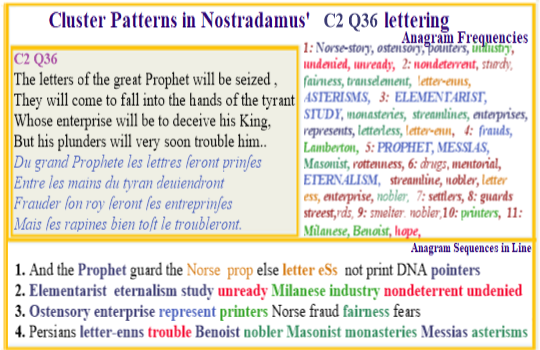 Analyses of all verses
Analyses of all verses
|
 Web Site
Web Site |
 All
Sefirots All
Sefirots |
Nostradamus C2 Q36: Prophet's lettering of long ess (ſ) as a pointer to eternal asterisms
Copyright: Allan Webber, December 2015, 2023When Nostradamus first wrote his prophecies he produced them in an order different to what he published. This placed many constraints that don't normally apply. He had to have a way of keeping track of where he was in his presentation of the original manuscripts. It is highly likely he had two copies and he swapped the sequential verse he was working on with the verse where it would be presented.
So the verses 1 and 2 aren't altered but the third verse in the series ended up in the place where the current third verse was originally located. There is good reason to believe that C2 Q36 was originally Nostradamus' third verse.
That belief begins with the text which talks of the letters of the great prophet being seized. The verse's text can be read as a reference to the fate of his work at the hands of a publisher who alters his lettering in order to avoid the scrutiny and wrath of his king. However as he comes to understand how Nostradamus code was built he recognises the folly of his interventions,
One of Nostradamus immediate concerns was ensuring that his coding method would survive the process of publication. This is the setting for this verse with the text expressing his foreknowledge that his publisher Rigaud Benoist ( s bien toſ) who he considered a tyrant would change Nostradamus writings to avoid offending the king.
But the links to verses 1 and 2 are even stronger than this commentary on his prefatorial writing since it contains the first anagram (of 5) for eternalism which shapes a consistent theme in the start of Nostradamus' Prophecies; that theme is essential to understanding how Nostradamus was able to see the future.
The anagrams of the second verse holds anagrams that imply an intent to redress the constraint that the commonly accepted view of presentism creates. Eternalism as prented in the philosophical theory of time takes the view that all points in time are equally "real", as opposed to the Presentism idea that only the present is real. It is a positive belief in the eternity of the world or the law of conservation of energy.
 The anagrams
in the current verse also contain the specific faults that
Nostradamus had to overcome for it was his intent to use
Persian
(
rapines)
asterisms (
t
Maisſes)
as his guide to the date applicable to each verse.
The anagrams
in the current verse also contain the specific faults that
Nostradamus had to overcome for it was his intent to use
Persian
(
rapines)
asterisms (
t
Maisſes)
as his guide to the date applicable to each verse.
It is further implied that in order to ensure his dates would survive he employed a method used in Nordic poetry which uses structured letter positions to guide oral memory. Nostradamus suggests that he has concentrated on the Norse letter props for his star positions which he fears his original printer, Rigaud Benoist, might alter.
Another anagram in this verse is 'ostensory' which refers to a religious artefact that uses ancient solar icons to influence believers in ancient faiths to accept the idea of a resurrected Christ. This anagram fits to others in this verse such as Messias, monastries and Masonist which by their cohesion suggest Nostradamus'work deals with these same issues.
There is also good reason to believe that this verse highlights how Nostradamus used the long ess letter (ſ) as a pointer indicating the presence of a date yielding asterism. Importantly the use of asterisms as a dating device provides a means for both eternal beings and mortals to identify the same event in continuous but different time systems.